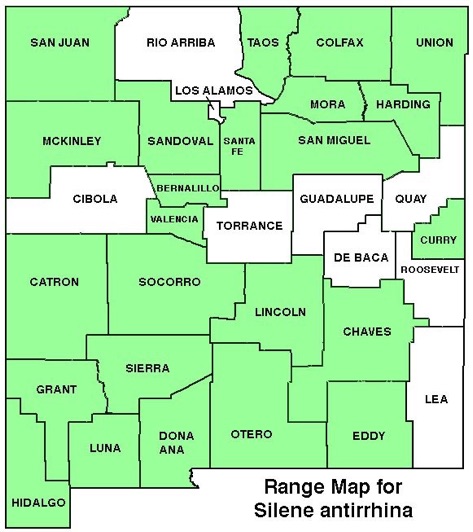WILDFLOWERS OF NEW MEXICO

This nondescript plant ranges almost statewide in dry sandy, gravelly hills and weedy, disturbed places. The slender, erect, hairless stems reach 32 inches tall with few branches. Note the reddish sticky, bands along the thin stems between leaf nodes. The football-shaped calyx below the petals has 10 distinctive ribs. True to its common name, the sticky patches on the stems often fatally trap insects, and it’s “sleepy” because the petals don’t open until full mid-morning sunlight.
FLOWER: March–May. Flowers about 1/4 inch wide (6 mm) with 5 small petals white to pink to rose, often bicolored with white interiors and red backsides, and often cleft with 2 shallow lobes. The petals barely extend beyond the oval calyx of 5 united sepals with 10 longitudinal ribs; calyx is hairless (glabrous).
LEAVES: Basal and opposite, sparsely spread along the stem. Blades sessile (without stalks), linear to lance-shaped, 1–2 inches long (2.5–5 cm), 1/16–1/2 inch wide (2–12 mm); surfaces hairless, rough; margins entire except with ciliate hairs on leaves near the base of the plant.
HABITAT: Dry sandy, gravelly soils; hills, fields, roadsides, disturbed areas; desert grasslands and scrub, pinyon-juniper woodlands, ponderosa-Douglas fir forests.
ELEVATION: 3,600–8,450 feet.
RANGE: Nationwide in all states.
SIMILAR SPECIES: The tiny flowers and sticky bands on the stem distinguish this species. Numerous variations in size and flower color occur both geographically and environmentally.
NM COUNTIES: Nearly statewide in low- to mid-elevation, dry habitats: Bernalillo, Catron, Chaves, Colfax, Curry, Dona Ana, Eddy, Grant, Harding, Hidalgo, Lincoln, Luna, McKinley, Mora, Otero, San Juan, San Miguel, Sandoval, Santa Fe, Sierra, Socorro, Taos, Union, Valencia.
NOTES: Bumblebees are reported to pollinate this and other Silene species. Ants, who steal nectar without pollinating the flowers, as well as small bees, flies, and aphids get trapped on the sticky stems.









SLEEPY CATCHFLY
SILENE ANTIRRHINA
Pink Family, Caryophyllaceae
Annual herb









THE CONTENTS OF THIS WEBSITE ARE COPYRIGHTED AND CANNOT BE USED
WITHOUT PERMISSION OF GEORGE OXFORD MILLER
















EMAIL ME




































The inflated, oval calyx has 10 ribs, and dries into a seed capsule.


Sticky patches on the stem can catch ants , small bees, and wasps.
















